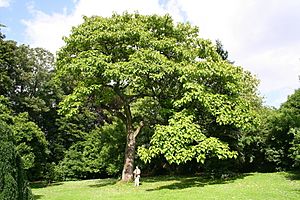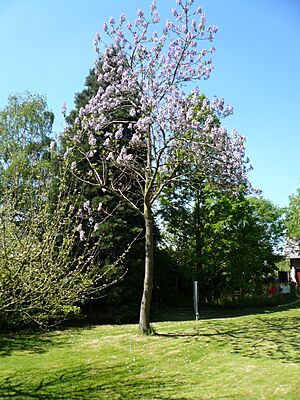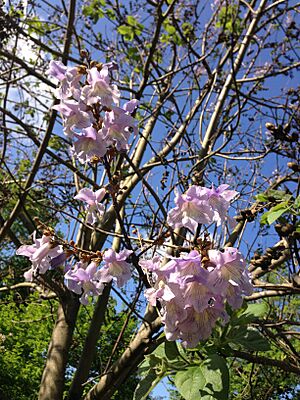Princess tree facts for kids
Quick facts for kids Princess tree |
|
|---|---|
 |
|
| Scientific classification | |
| Genus: |
Paulownia
|
| Species: |
tomentosa
|
The Princess tree (scientific name: Paulownia tomentosa) is also known as the Empress tree or Foxglove-tree. It is a tree that loses its leaves every year (deciduous). This tree belongs to the Paulowniaceae family and originally comes from central and western China.
The Princess tree grows very quickly. Its seeds spread easily, which means it can grow in many places. It has become a common plant in North America, especially in the Eastern United States. It has also spread to Western and Central Europe.
Contents
What's in a Name?
The name Paulownia was chosen to honor Anna Pavlovna of Russia. She was a princess and later a queen. The second part of the scientific name, tomentosa, is a Latin word. It means 'covered in hairs', which describes parts of the tree.
Tree Features and Growth
This tree can grow quite tall, usually between 10 and 25 meters (about 33 to 82 feet). Its leaves are very large, shaped like a heart or with five lobes. They can be 15 to 40 centimeters (about 6 to 16 inches) wide. The leaves grow in pairs on the stem. On younger parts of the tree, the leaves might grow in groups of three and be even bigger. Sometimes, people might confuse its leaves with those of the catalpa tree.
Flowers and Fruit
The Princess tree has very fragrant flowers. They appear in early spring, even before the leaves grow. These flowers grow in clusters called panicles, which are 10 to 30 centimeters (about 4 to 12 inches) long. Each flower looks like a foxglove flower. They have a tube-shaped purple corolla (the part that looks like petals) that is 4 to 6 centimeters long.
After the flowers, the tree produces fruit. The fruit is a dry, egg-shaped capsule, about 3 to 4 centimeters long. Inside, there are many tiny seeds. These seeds have wings, which helps them spread easily by wind and water. If a tree is cut back hard (a process called pollarding), it won't produce flowers. This is because flowers only grow on older wood.
Growing Conditions
The Princess tree needs lots of sunlight to grow well. It can handle pollution and can grow in many different types of soil. You might even see it growing from small cracks in sidewalks or walls! This tree can also survive wildfires. Its roots can grow new, very fast-growing stems after a fire.
How People Use the Princess Tree
The Princess tree is often planted in parks and gardens because it is a beautiful ornamental tree. It has even received an award for its garden value.
Ecological Role
Because it is so tough and adaptable, the Princess tree acts as a "pioneer plant." This means it is one of the first plants to grow in new or disturbed areas. Its leaves are rich in nitrogen, which makes good food for animals. Its roots also help stop soil from washing away (erosion). Over time, taller trees might grow and shade out the Princess tree. It cannot grow well in deep shade.
Princess trees are also good for the environment. One acre of these trees can absorb a huge amount of carbon dioxide each year. This is a gas that contributes to climate change. When the trees are fully grown, their wood can be used to build houses or make musical instruments.
Special Gardening Use
Gardeners sometimes cut the tree back very hard each year. This makes the tree produce huge new leaves, sometimes up to 60 centimeters (23 inches) across! This is a popular technique in modern gardening to create a dramatic look with large, "architectural" plants.
Cultural Uses
In Japan, there is a special tradition. A Princess tree is planted when a girl is born. The tree grows quickly, just like the girl. When she is old enough to get married, the tree is cut down. Its wood is then carved into beautiful items for her dowry. Carving Paulownia wood is a special art form in Japan.
There's also a legend in Japan that says the phoenix bird will only land on a Princess tree. This is said to happen only when a good ruler is in charge. Many Asian string instruments are made from this wood. These include the Japanese koto and the Korean gayageum zithers.
Packing Material and Spread
In the 1800s, Chinese companies used the soft, lightweight seeds of the Princess tree as packing material. They used them to protect delicate porcelain items during shipping. This was before modern packaging like polystyrene was invented. Sometimes, the packing cases would break open during travel. This caused the seeds to scatter along railway tracks. Because so many seeds were used for packing, and also because people planted them for decoration, the tree has spread widely. It is now considered an invasive species in places where the climate is right for it, like Japan and the eastern United States.
Pictures
See also
 In Spanish: Paulonia imperial para niños
In Spanish: Paulonia imperial para niños











